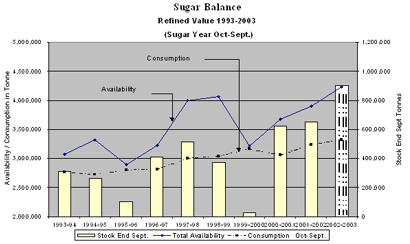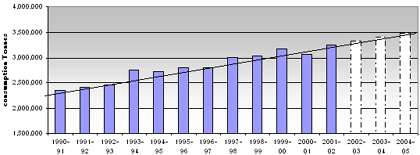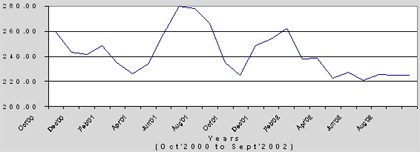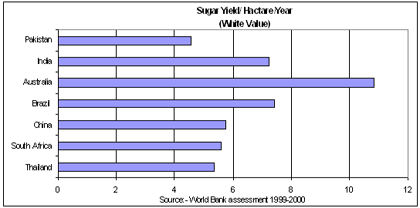2002-03
Statistics show that over 600,000 tonnes of sugar would be available
with the mills, on 1st October 2002. The supply of irrigation water is
satisfactory, and the crop condition promise a bumper harvest. Our conservative
estimates are for over 3.50 million tonnes of sugar, which will raise
the availability of sugar to over 4.10 tonnes against estimated consumption
of 3.35 million tonnes.

High domestic production at the time of global surplus and expected further
low prices, the sugar industry foresees a gloomy picture and finds no
reason to be jubilant. In the national interest the promising crop and
the sugar production is a matter of great satisfaction, as long it is
handled properly for its perpetual progress.
Appreciating the situation PSMA proposes delay in start of crushing season
2002-03 by two month, and arrangements of atleast 500,000 tonnes of sugar
export by the start of the crushing season 2002-03, to avoid a total disaster
during the ensuing season.
Domestic Consumption
Realizing the impact of a reliable consumption data, we have reproduced
the main features already presented in our last Annual Report 2001. The
data is improved and projected further forming a model base for use as
guideline for future planning.
In the recent past 21 kg was being used as per capita consumption of
refined sugar. In this case an estimated figure is applied to another
estimated figure of population i.e. two uncertain figures are used, to
arrive at an important figure of consumption, forming a base for planning
and ascertaining import and exports of sugar, that has been causing controversies,
resulting in over imports and obstructing export of surplus sugar.
In a recent study prepared by PSMA, precise collection of monthly imports,
exports and supplies from mills, taking an account of carryover stocks,
a fair model of 10 years consumption data was established. This shows
pretty regular rate of growth in simple progression of about 3.48% annually
with 1990-91 consumption taken as bench mark (2,342,158 Tonnes) Annual
average increase in consumption, records 81,622 tonnes. Sugar consumption
growth is slightly higher than the population growth of 2.96 % with 1991
population 112.6 million taken as bench mark (145.96 – year 2002).
The difference marks the increase in the per capita consumption, now firmly
established as 22 Kg, which coincides with our consumption figure of 270,000
tonnes conveyed to the Government. The attached projection forecasts consumption
of around 3.5 million tonnes for the year 2004-05. The industry must be
prepared to face the challenge.
Minor annual fluctuations, temporary in nature are always possible,
which are due to:-
i.) End month’s mills sales , accounted for as supply in that particular
month.
ii.) Similarly late import arrivals are included in the supplies, consumed
later.
iii.) Substantial domestic price fall attracts higher sale for a short
period.
iv.) Fluctuating supplies to Afghanistan can easily bring a substantial
difference.
v.) Stocks held in market also fluctuate.
Our members as well as Government concerned officials will now have a
clear understanding of the consumption and its growth, basically worked
out on 12 months basis each year Oct/ Sept.
Pakistan Sugar Mills Association
Consumption (1990-91 to 2001-02) & projected
Sugar Year Oct- Sept.

Global Sugar Scenario
For the crop year 2001-02 World sugar production and consumption from
different sources is averaged at 126.45 million tonnes against 122.6 million
tonnes consumption (white values). The output exceeding the demand by
about 4.0 million tonnes, the surplus would lead to global surplus stock
of 60.0 million tonnes at the end of August 2002.
The crop year 2002-03 would be another surplus year with the world surplus
already touching about 17.0 million tonnes. With the exception of India,
where the crop expectation is 15-20% lower due to unfavorable monsoon,
other major sugar producing countries are expecting massive cane crop,
and hence there could be little doubt that market will remain over supplied
for the next 18 months. It is an agreed fact by the global sugar experts,
that the market can not recover un-till the surplus disappears, and consumption
catches up with the production.
World Monthly Refined Sugar Prices (US$ Per Tonne)

With the global output seen at 131 million tonnes in 2002-03 crop year
and consumption estimated at 125 million tonnes world sugar prices are
to stay low for the next year or two according to major analysts, the
start of the effect is depicted in the above graph.
The global surplus and the continued downward trend will invariably
have direct impact on the countries like Pakistan, where domestic production
cost is much higher than the major sugar producing and exporting countries.
Economy of the sugar production is measured by the ultimate product i.e.
sugar in tonnes per hectare. Comparing the out put of the different countries
in sugar production per hectare, indicates a combined result of the yield,
recovery % age, efficiency etc. The following graph shows Pakistan’s
best standing in comparison to the countries that matter as for as the
production and Trade of the surplus is concerned.

Unless revolutionary measures are taken to improve the sugarcane quality
and yield per acre it will have no standing to export its surplus in competition
to other countries. Its production would always remain under threat to
internal and external shocks.
The export of surplus sugar globally, is based on either very low production
cost or supported by various subsidies. These subsidies include crop subsidies,
subsidy on utilities to sugar mills, transport and sea freight subsidies,
duty draw backs on imported components, land rent and sugar plants cost,
lending rates and massive export rebate like that of around 450/- euros
per tonne by European Union.
Conclusion:-
- Sugar Industry was not responsible for the price hike at end 2000.
- Excessive import has caused huge losses to the industry and a continued
depressed sugar price.
- Present stock building and next year’s harvest is posing a
serious threat of about 900,000 tonnes surplus for the year 2002-03.
- Global surplus indicates continuation of low prices for the year
02-03.
Under the circumstances it is obvious that the sugar industry can not
sustain further losses. For the revival of the industry, to face the future
challenges and meet the national demand, it is proposed that:-
(1) crushing campaign 2002-03 should be delayed for atleast two months.
(2) government should provide means against losses for exporting minimum
500,000 tonnes of sugar by the start of 2002-03 crushing season.
OR
(3) The sugar industry be authorized to limit its production to the domestic
demand only.
(4) Immediate enhancement in import tariff on sugar be imposed by minimum
30% on top of present rate of 25% to curb import of sugar (Refined &
Raw)
(5) Sale tax issues of additional 3% on sugar and sale tax payment deferment
be attended to, at the earliest.
(6) First step taken by the government in getting rid of the support price
system on sugarcane, be further tuned to free market mechanism by eliminating
the indicative price as well, to stop controversies.
We hope that with little attention by the Government, persistent policy,
vigorous effort towards research and development of the sugarcane crop,
the industry can be revived to face the growing future challenges. Let
us hope that objective efforts are jointly made to save the industry being
called un-viable and victim to mismanagement etc. Government should also
realize that to protect the interest of the consumer and the growers,
the source is to be protected, strengthened and developed on priority
as a base.
To conclude, I thank the Zonal Chairmen and members of the Central Executive
Committee as well as the zonal committees for their support and co-operation.
PSMA secretariats have always been maintaining data and vital information
in support of PSMA’s stance on important issues, which has always
been a great help when presenting our case to the Government. Our thanks
to the central as well as the zonal secretariats for their dedicated efforts.
|
